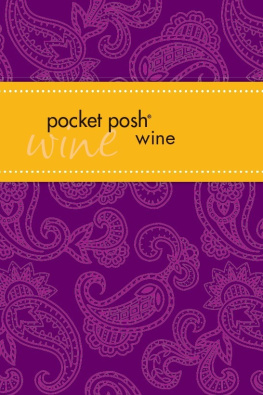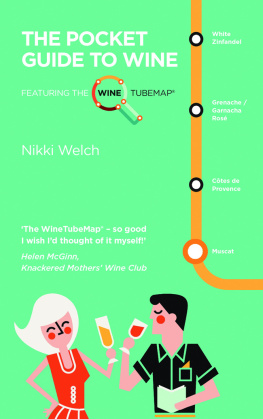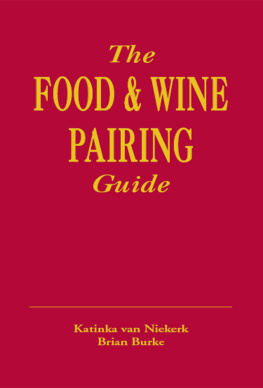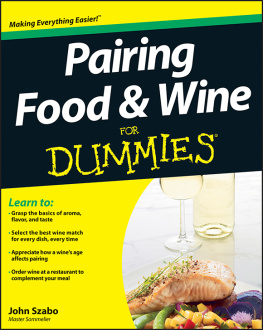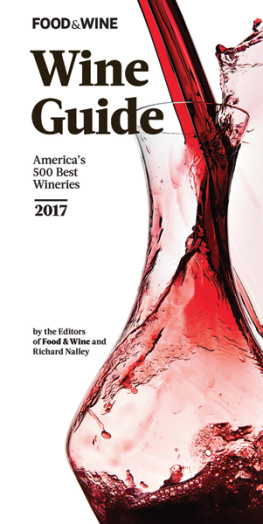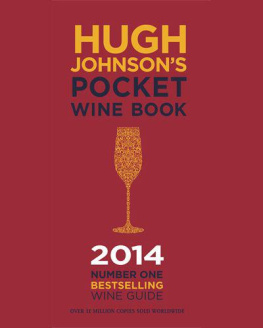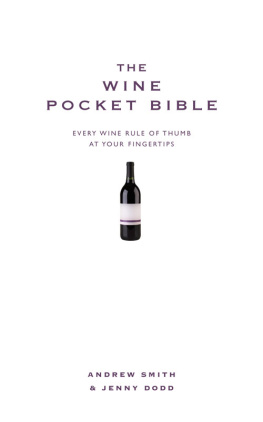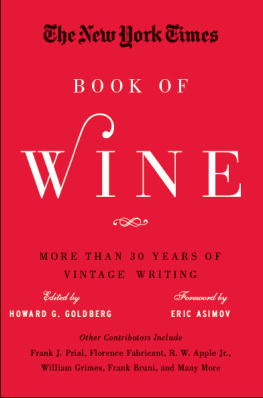Paulo Carminati - Pocket Posh Wine
Here you can read online Paulo Carminati - Pocket Posh Wine full text of the book (entire story) in english for free. Download pdf and epub, get meaning, cover and reviews about this ebook. year: 2011, publisher: Andrews McMeel Publishing, genre: Home and family. Description of the work, (preface) as well as reviews are available. Best literature library LitArk.com created for fans of good reading and offers a wide selection of genres:
Romance novel
Science fiction
Adventure
Detective
Science
History
Home and family
Prose
Art
Politics
Computer
Non-fiction
Religion
Business
Children
Humor
Choose a favorite category and find really read worthwhile books. Enjoy immersion in the world of imagination, feel the emotions of the characters or learn something new for yourself, make an fascinating discovery.
- Book:Pocket Posh Wine
- Author:
- Publisher:Andrews McMeel Publishing
- Genre:
- Year:2011
- Rating:5 / 5
- Favourites:Add to favourites
- Your mark:
- 100
- 1
- 2
- 3
- 4
- 5
Pocket Posh Wine: summary, description and annotation
We offer to read an annotation, description, summary or preface (depends on what the author of the book "Pocket Posh Wine" wrote himself). If you haven't found the necessary information about the book — write in the comments, we will try to find it.
Professional Paulo Carminatis tips on purchasing wine and pairing wine with food are offered along with a handy tutorial on the art of winespeak in Pocket Posh Wine.
Pocket Posh Wine — read online for free the complete book (whole text) full work
Below is the text of the book, divided by pages. System saving the place of the last page read, allows you to conveniently read the book "Pocket Posh Wine" online for free, without having to search again every time where you left off. Put a bookmark, and you can go to the page where you finished reading at any time.
Font size:
Interval:
Bookmark:



Produced by

| President | Julie Merberg |
| Senior Vice President | Patty Brown |
| Layout by | Laura Smyth/Smythtype Design |
| Special Thanks | Sarah Parvis, LeeAnn Pemberton |
POCKET POSH WINE
copyright 2011 by Downtown Bookworks, Inc. All rights reserved. No part of this book may be used or reproduced in any manner whatsoever without written permission except in the case of reprints in the context of reviews.
Andrews McMeel Publishing, LLC
an Andrews McMeel Universal company
1130 Walnut Street, Kansas City, Missouri 64106
www.andrewsmcmeel.com
E-ISBN: 978-1-4494-0772-8
Library of Congress Control Number: 2011925220
APPR
ATTENTION: SCHOOLS AND BUSINESSES
Andrews McMeel books are available at quantity discounts with bulk purchase for educational, business, or sales promotional use. For information, please e-mail the Andrews McMeel Publishing Special Sales Department:

organic, biodynamic,
and sulfite-free crazes

One of the reasons becoming knowledgeable about wine can be so offputting is that those who do know a lot about wine toss out words unfamiliar to most people. Here we try to address some of the more egregious examples of winespeak into terms everyone can understand.
A lot of winespeak refers to the winemaking process, so lets begin with a quick description of how wine is made, inserting vocabulary explanations where appropriate:
Step One: The grapes grow over the course of a few months. They develop a particular sugar level (known as brix) and acidity.
Step Two: When the grapes are ripe, they are harvested and either pressed to extract the juice (most white wines) or crushed into a combination of skins and juice called the must (most red wines). Yeast is added and feeds off of the sugars, resulting in carbon dioxide (which escapes into the atmosphere) and alcohol (which gives the wine structure and body).
Step Three: A secondary fermentation may sometimes occur that converts the natural malic acid of grapes (think apples) to lactic acid (think dairy products).
Step Four: The wine can then be aged or bottled directly.
Aperitif: This means the wine is good as an appetizer. Usually light, crisp, and consumed on their own or with lighter fare, these wines are meant to cleanse and prep the palate for whats to come. Sparkling wine, Sauvignon Blanc, and dry, crisp ross fall into this category.
Appellation: A geographically delineated wine region, recognized by the appropriate governing bodies in each country. For example, France has its A.O.C. (Appellation dOrigine Contrle), and Italy has its D.O.C. (Denominazione di Origine Controllata). This way, theres no mistaking whether a wine comes from Napa, for example, or just outside.
Aroma: The three levels of aromas in wine come from the three stages of a wines life. Primary aromas are derived from the grape itself (fruits and woody stems), secondary aromas from the winemaking process, and tertiary aromas from the wine as it ages. The aromas from barrel aging straddle both secondary and tertiary, but bottle aging is always tertiary.
Barrels ( barriques in French): Usually made of oak and used to age wine. The oak is semipermeable, allowing for a very slow, steady exposure to air and a controlled environment for wine to develop and age accordingly. Malolactic fermentation commonly occurs in oak barrels. See Malolactic fermentation .
Blind tasting: When people try and assess a wine without knowing anything about it. Meant to showcase a persons talent in tasting wine and allow one to evaluate the wine without any preconceptions (such as those based on the price or producer).
Bodega: Wine cellar in Spanish ( adega in Portuguese, cantina in Italian). For cultures where many families make their own wine for consumption, bodega also implies a familys summer house or cottage (where the wine is usually made and stored).
Bordeaux: A region in southwestern France famous for its Cabernet Sauvignonbased and Merlot-based red wines. Traditionally a Bordeaux blend consisted of five grapes: Cabernet Sauvignon, Merlot, Cabernet Franc, Petit Verdot, and Malbec.
Bouquet: Either the combination of a wines aromas or another way of saying a wines tertiary aroma, depending on whom you ask. Sometimes defined as human-made (i.e., the winemakers influence) scents rather than those intrinsic to the grape.
Breathing: Specifically, letting a wine breathe. When wine interacts with air, the oxygen breaks down molecules in the wine, releasing more aromas and mellowing out more astringent wines (by oxidizing tannins). Young wines will show more balance and older wines will be reinvigorated, though by how much depends on the wine. See Decanting .
Burgundy: A region in eastern France famous for its Pinot Noir (red Burgundy) and Chardonnay (white Burgundy).
Capsule: The top of the wine bottle (usually foil or plastic for screwtops). Meant to seal the cork in and provide identification (when resting in a wine rack).
Carbonic maceration: A fermentation process popular in Frances Beaujolais region, where whole grapes are loaded into a sealed vat pumped full of carbon dioxide. The juice from the grapes ferments inside the grape (rather than outside after the grape is pressed). The result is a very fruity wine with hardly any tannins and a hint of bubblegum flavor.
Cpage: French term usually referring to the blend of different grapes in a wine.
Chaptalization: When a winemaker adds sugar to the grape must before fermentation. Usually done to compensate for poor grapes with low sugar levels to reach an acceptable alcohol level after fermentation. Illegal in some countries.
Chteau: Traditional French term for winery , originating in Bordeaux.
Claret: A British name for red blends from Bordeaux and similar styles, predominantly Cabernet Sauvignon and Merlot. American clarets are sometimes called Meritage.
Ctes du Rhne: An officially designated French region (A.O.C.) with wines usually featuring the typical blend of red grapes (Grenache, Syrah, and Mourvdre) from the region.
Cru: French term meaning growth and referring to the vines in a particular region. For example, in Burgundy the term Premier Cru refers to a first in class location of vines and Grand Cru a greatest and in a class of its own location.
Cult wines: Small production, high-quality, and even higher-demand wines that most people never see or try.
Cuve: French term, literally meaning vat and implying a blend of grapes or wines mixed in said vat.
Decanting: The process of removing the wine from a bottle into another container (e.g., glass, decanter). The purpose is twofold: to remove any sediment that is present in the wine and to aerate the wine.
Font size:
Interval:
Bookmark:
Similar books «Pocket Posh Wine»
Look at similar books to Pocket Posh Wine. We have selected literature similar in name and meaning in the hope of providing readers with more options to find new, interesting, not yet read works.
Discussion, reviews of the book Pocket Posh Wine and just readers' own opinions. Leave your comments, write what you think about the work, its meaning or the main characters. Specify what exactly you liked and what you didn't like, and why you think so.

